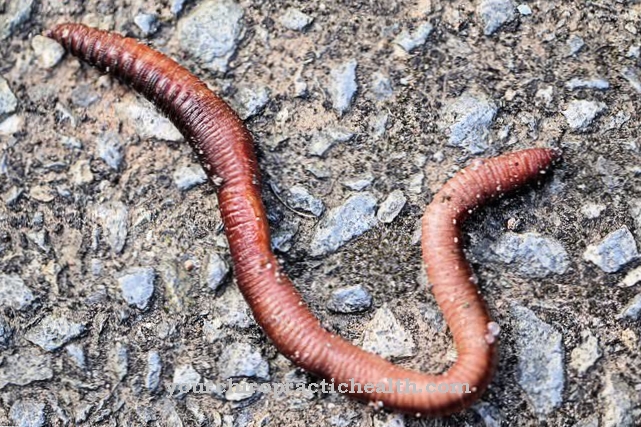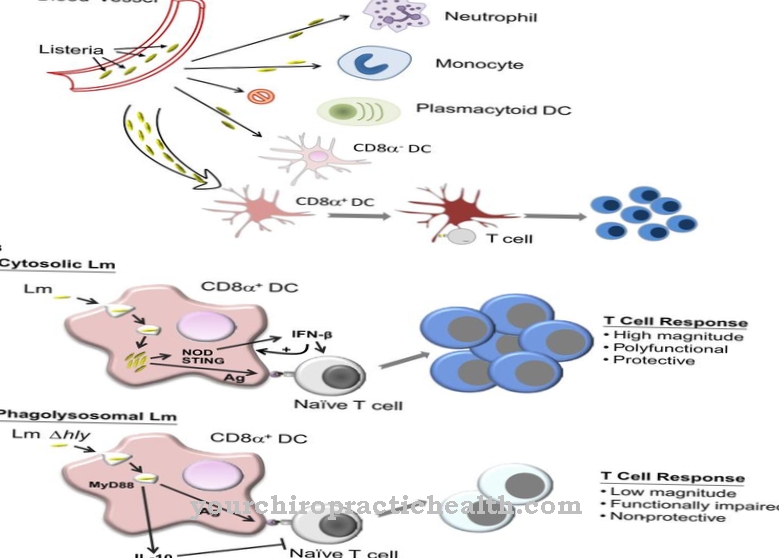Of the Varicella zoster virus (VZV) belongs to the DNA virus forms. It can cause chickenpox and shingles. VZV is a herpes virus.
What is the varicella zoster virus?
Humans are the only natural hosts for these herpes viruses. They are common worldwide. Of the Varicella zoster virus is enveloped by a membrane. This membrane contains a double-stranded DNA. The virus also consists of an icosahedral capsid. This is a small capsule made up of a fixed number of protein units. The capsid of the VZV contains 162 capsomeres. A virus unit has a maximum diameter of 200 nm. The varicella zoster virus belongs to the genus Varicellovirus and is closely related to the herpes simplex virus. About 95 percent of the population have antibodies against this virus.
Meaning & function
The varicella zoster virus is highly contagious. VZV is transmitted very quickly and easily through droplet infection. Upon first contact with the pathogen, it leads to a varicella infection, also known as chickenpox.
The name came about because of the high risk of infection. Even at a distance of a few meters, the viruses can be contagious "over the wind" as droplet infections. Young children who have not yet been vaccinated are mainly affected by chickenpox. Chickenpox is therefore one of the teething problems.
The incubation period of the disease is usually 14-16 days. Affected patients become contagious about 2 days before the rash becomes visible. The risk of infection continues until the blisters are crusted on the skin. The disease begins with a fever and an itchy rash (exanthema). The skin changes are the typical feature of the disease.
These exanthema consist of papules, vesicles and scabs. They are in different stages of development and are also called “starry skies”. These skin changes develop on the face and core of the body. They can later spread to other parts of the body, affecting an insistent scalp or mucous membranes. Chickenpox usually heals without scarring.
However, if a bacterial superinfection occurs or if the rash is severely scratched, scarring can occur. Diseases with chickenpox are characterized by a typical clinical picture. Special diagnostics are only required in selected cases.
Dangers, disorders, risks and diseases caused by the varicella zoster virus
People with immune deficiencies in particular can be life-threatening. Chickenpox infection is also very dangerous during pregnancy. Infections of the fetus before the 20th week of pregnancy can lead to malformations and abortions.
Unfortunately, there is no effective therapy for chickenpox. Those affected have to cure the viral disease. Bed rest, antipruritic agents, and calf wraps if you have a fever are the recommended measures. The best prevention against chickenpox is timely vaccination. The recommended vaccination age is between 12 and 18 months. Vaccinated children and adults are protected from infection by up to 95 percent because they produce sufficient antibodies.
Chickenpox caused by the varicella zoster virus is considered the primary disease. After a long period of rest, elderly people and a weakened immune system can cause the viruses to multiply again in the body.
This virus replication can trigger a second disease with shingles (herpes zoster). This viral disease is usually visible as a striped rash on the middle of the body. A nerve becomes inflamed and spreads this inflammation to the surrounding skin tissue.
Herpes zoster is an endogenous reactivation. So it is not contagious and cannot be transmitted. It only ever arises from a renewed activation of the varicella zoster viruses, which remain in the body even after infection with chickenpox. They are located in the nerve roots of the spinal cord and the ganglia of the cranial nerves. Herpes zoster is associated with severe pain. The area of skin that supplies the inflamed nerve also burns. In the early stages, there may be a slight fever and fatigue. The shingles develops in phases. First, painful bumps develop on the skin, which later turn into blisters. These vesicles burst after a few days and form a yellowish bark. The shingles heals after about two to three weeks.
Scarring is common. Chronic courses with frequent blistering can also occur. Shingles can be treated with antivirals. It is a substance that prevents viruses from multiplying in the body. There are no drugs that can directly destroy the virus. It is only possible to prevent it from spreading.
It is also common for herpes zoster to administer strong pain relievers. If the patient had previously received a vaccination against chickenpox, the infection with shingles will be less intense. If shingles are treated properly in the first few days, secondary diseases such as postherpetic neuralgia can be avoided.


.jpg)










.jpg)

.jpg)
.jpg)











.jpg)